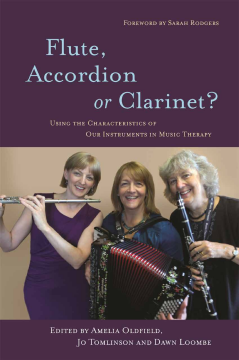
BOOK
Flute, Accordion or Clarinet?
Dawn Loombe | Jo Tomlinson | Amelia Oldfield | Henry Dunn | Catrin Piears-Banton | Colette Salkeld | Susan Greenhalgh | Caroline Anderson | Emily Corke | Mary-Clare Fearn | Esther Mitchell | Philip Hughes | Annie Tyhurst | Catherine Warner | Tessa Watson | Philippa Derrington | Mike Gilroy | Shlomi Hason | Concetta Tomaino | Penelope Birnstingl | Lisa Margetts | Grace Watts | Katy Bell | Nicky Haire | Trisha Montague | Sharon Warnes | Angela Harrison | Oonagh Jones | Rivka Gottlieb | Anna Lockett | Holly Mentzer | Steve Lyons | Jonathan Poole | Caroline Long | Alex Street | Prodromos Stylianou | Trygve Aasgaard | George Murray | Helen Mottram | Nathan Bettany | Stella Compton-Dickinson | Spela Loti Knoll | Luke Annesley | Susanna Crociani | Billy Davidson | Anita Vaz | Paolo Pizziolo | Joseph Piccinnini | John Preston | Veronica Austin | Sarah Rodgers | Joanna Burley
(2015)
Additional Information
Book Details
Abstract
Music therapists are trained to use their first study instrument in clinical practice, yet existing literature focuses almost exclusively on the use of piano, basic percussion and voice.
This illuminating book brings together international music therapists who use a diverse range of musical instruments in their clinical work: the clarinet, the piano accordion, the flute, the cello, the trumpet and flugelhorn, the bassoon, the violin, the viola, the harp, the guitar, lower brass instruments (the trombone and the euphonium), the oboe, the saxophone and bass instruments (double bass and bass guitar). Each therapist reflects on their relationship with their instrument and the ways in which they use it in therapeutic settings, discussing its advantages and disadvantages in a variety of clinical populations: children and adolescents, adults with learning disabilities, adults with mental health problems and older people.
This will be essential reading for any music therapist or student music therapist who uses or is interested in using a musical instrument in their work, and will be of interest to other caring and healthcare professionals, teachers, musicians and carers wanting to learn more about instrumental music therapy.
Amelia Oldfield has worked as a music therapist with children and families for over 34 years. She currently practices as a clinician in Child and Family Psychiatry in Cambridge and lectures as a music therapy professor at Anglia Ruskin University where she co-initiated the MA Music Therapy Training in 1994. She is an enthusiastic clarinettist who performs regularly in various chamber music ensembles around Cambridge. Jo Tomlinson has been working as a music therapist in schools in Cambridgeshire since 1995 and was Head Music Therapist for Cambridgeshire Music from 2002-2006. Jo is a performing musician on both flute and piano. She is currently writing up a PhD thesis at Anglia Ruskin University based on a research project in a special school. Dawn Loombe is a piano accordionist, accordion teacher and music therapist. She currently works as a music therapist at the Child Development Centre, Addenbrooke's Hospital Cambridge and also in private practice with adults with profound and multiple learning disabilities. She has also worked in schools, children's centres and in residential care homes. Dawn performs as both a solo accordionist and with a variety of musicians and vocalists.
This is a fascinating book. The use by music therapists of instruments other than the keyboard is central to much clinical practice, but as yet no comprehensive discussion of the implications and possibilities of such work has been published. This book fills that space admirably; its detailed accounts of the characteristics of instruments and instrumental families are complemented by a wealth of case material and illustrations which bring clinical events excitingly to life. Students and long established therapists alike will find plenty here to enliven their practice.
Eleanor Richards, Senior Lecturer and Clinical Placement Co-ordinator, MA Music Therapy, Anglia Ruskin University, Cambridge
Flute Accordion or Clarinet is a refreshing addition to music therapy literature. With instrumental history, case vignettes and very handy chapter summaries it truly showcases how each instrument can be used to greatly enhance the music therapy experience. It has certainly inspired me to increase the use of my flute in sessions!
Maria Ramey, private practice music therapist, Massachusetts and author of Group Music Activities for Adults with Intellectual and Developmental Disabilities
Table of Contents
| Section Title | Page | Action | Price |
|---|---|---|---|
| Flute, Accordion or Clarinet? | 1 | ||
| Foreword | 7 | ||
| Acknowledgements | 11 | ||
| Introduction | 13 | ||
| Chapter 1. The Clarinet | 21 | ||
| Chapter 2. The Piano Accordion | 41 | ||
| Chapter 3. The Flute | 69 | ||
| Chapter 4. The Cello | 95 | ||
| Chapter 5. The Trumpet and the Flugelhorn | 111 | ||
| Chapter 6. The Bassoon | 135 | ||
| Chapter 7. The Violin | 147 | ||
| Chapter 8. The Viola | 165 | ||
| Chapter 9. The Harp | 177 | ||
| Appendix 9.1: Harp therapy training | 192 | ||
| Appendix 9.2: Music-thanatology training | 196 | ||
| Chapter 10. The Guitar | 199 | ||
| Chapter 11. Lower Brass (the Trombone and the Euphonium) | 225 | ||
| Chapter 12. The Oboe | 247 | ||
| Chapter 13. The Saxophone | 265 | ||
| Chapter 14. The Bass \n(the Double Bass and the Bass Guitar) | 287 | ||
| Reflections | 309 | ||
| Authors’ Biographies | 316 | ||
| Subject Index | 333 | ||
| Author Index | 343 | ||
| Blank Page |
